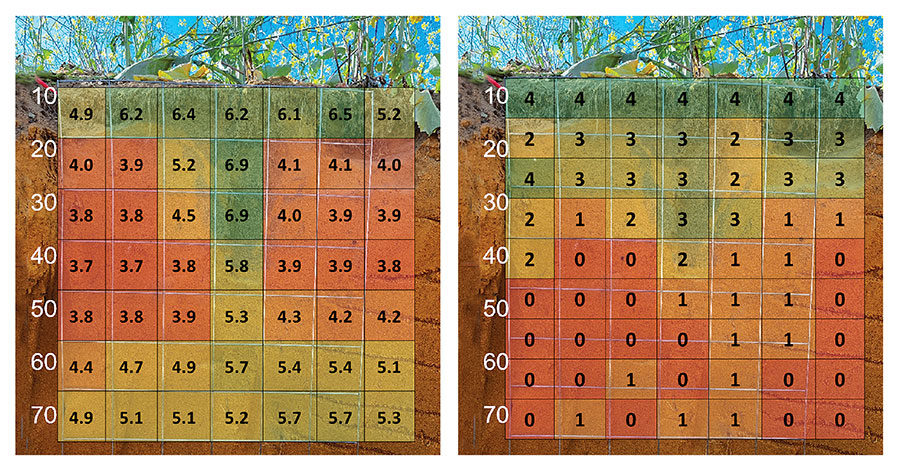Key points
- Even in a dry year, canola yield increased on paddocks that had been deep-ripped with topsoil inclusion four years earlier
- Four years after ripping, there was improvement in pH and lower bulk density along the rip line, enabling deeper root penetration to access moisture and nutrients
- These observations suggest that subsequent ripping be directed ‘off row’ to maximise the rip line effects across a paddock
Although Western Australian growers have gained much experience with deep ripping, there are still questions to be answered.
How often do you rip? Do you rip on or off the old rip line? What happens on ripped country in dry seasons?
Long-standing relationships with local growers have provided an opportunity for research scientist Bindi Isbister and a team from the Department of Primary Industries and Regional Development (DPIRD) to literally take a ‘deep dive’ to explore the nuances of crop performance on and off rip lines.
The work, supported by GRDC, is using grower case study paddocks to investigate aspects such as the longevity of deep ripping, inclusion of topsoil, and whether and where to deep rip next.
“Last year we were able to study a paddock in depth, using soil pits where the grower had sown his crop on and off the rip line,” Ms Isbister says.
Case studies such as this one enable us to look at a complex system and inspect aspects of it in detail. It is not a scientific investigation, but we can learn a lot from it.
“This particular case study was on Brad Smith’s property 75 kilometres east of Geraldton.”
The grower had been using variable-rate technology based on soil type since 2012 and soil sampling regularly.
The subject paddock had initially been deep-ripped in 2016 to about 450 millimetres, and then again in 2020. The rip lines were 60 centimetres apart and the grower was sowing on 31cm rows, with subsequent crops being sown in the interrow of the previous crop. Ms Isbister had been monitoring the paddock’s performance since 2019.
“We had been monitoring the paddock spatially to compare yield and soil property variations pre and post-amelioration. We were seeing an increase in yield after deep ripping and the fact that soil was not resettling in the rip lines,” she says.
“In July we observed there was more moisture in the rip lines than off, suggesting that the rip line had a water-harvesting effect. However, we didn’t have an opportunity in this study to measure those early moisture dynamics that could have contributed to early plant growth, with only one rainfall event greater than 10mm after seeding.
“In August 2023, soil pits were dug across the rip lines in three types of acidic yellow sand across the case study paddock: (A) a high-yielding fine sand, (B) a medium-yielding medium sand, and (C) a low-yielding coarse sand.”
Measurements were taken using a 10 by 10cm grid that included root abundance on the pit face, and soil testing at 10cm increments on and off the rip lines to ascertain bulk density, moisture, pH, extractable aluminium concentration and nutrition status. Harvest cuts were taken on and off the rip lines to estimate grain yield.
“We found that four years after ripping, the topsoil inclusion to nearly 45cm depth had created a pathway for roots, where there was better pH and lower bulk density, enabling the roots to access moisture and nutrients at depth.”
These changes were manifested in improved yields for canola in what was a dry year. Yields on the rip line were 24 to 77 per cent higher in a decile-one season with only 123mm of growing-season rainfall. Maximum yield was 1.36 tonnes per hectare.
Figure 1: Deep ripping an acidic deep sand to a depth of 45 centimetres with topsoil inclusion has provided a pathway for plants roots to penetrate deeper into the soil profile (centre of each image). Roots are visible pushing through the acidic subsoil layer at 20 to 50 centimetres, on the left, (Site C coarse sand Soil pH in calcium chloride) and right (Site C coarse sand). Root abundance score 0 = no roots, 4 = >25

Bindi Isbister, DPIRD
Canola yields on the rip lines were 1.33, 1.36 and 0.9t/ha compared to 0.8, 1.10 and 0.53t/ha at sites A, B and C respectively. Soil pH was significantly higher on the rip line for 20 to 50cm depth for all soil types compared to off the rip line.
Bulk density was lower in the rip line compared to off the rip line at 20 to 50cm for all sites. There was more organic carbon in 10 to 30cm on the rip line, for example, site B on 0.4 per cent, off 0.14 per cent and site C on 0.35 per cent and off 0.16 per cent.
“The higher organic carbon and root growth in the rip line could be helping to sustain and stabilise the ripped soil,” Ms Isbister says.
“These plant and soil measurements suggest that subsequent deep ripping with topsoil inclusion in the off row may be the next step rather than ripping deeper.
“This would expand the area that has been deep-ripped in the paddock and create an inclusion zone every 30cm, giving each crop row close proximity to a rip line with better fertility and higher moisture each season. This would further increase crop yield and extend the longevity of the ripping benefit.”
More information: Bindi Isbister, bindi.isbister@dpird.wa.gov.au

























































